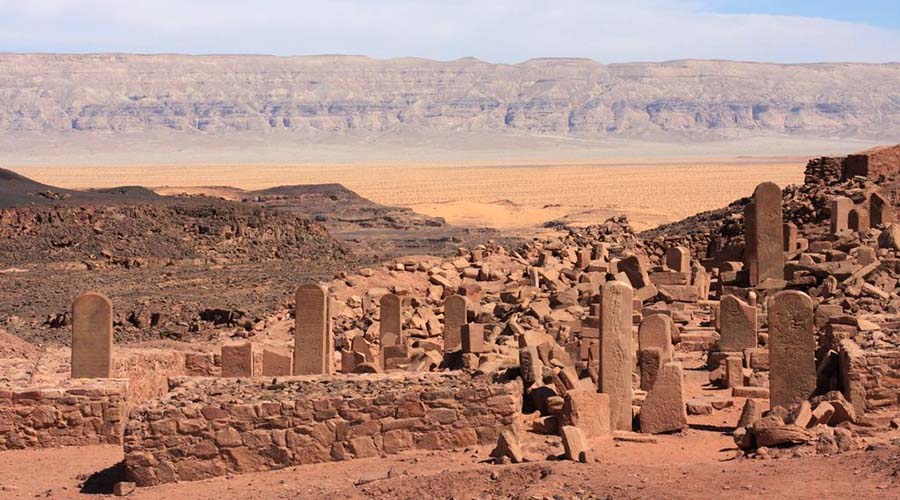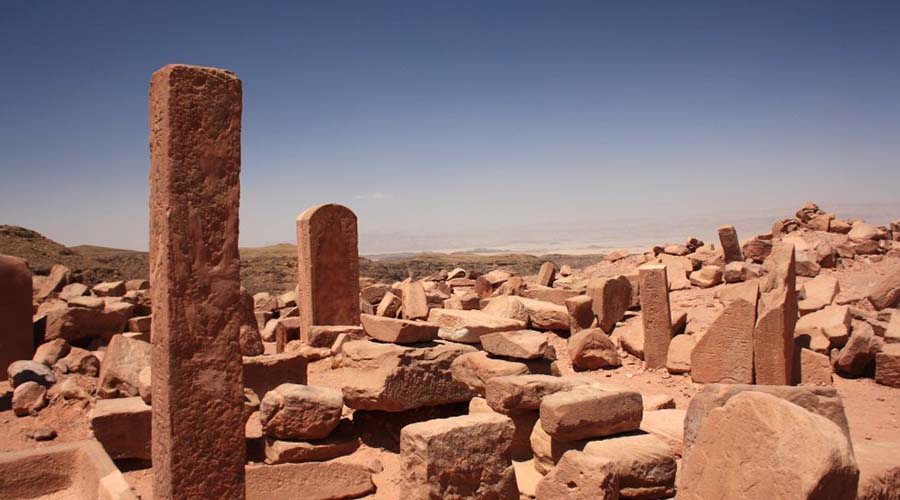Serabit El Khadem temple Egypt information, tours, prices and online booking
Serabit El Khadem temple stands on a massive rocky outcrop. It is in fact at an altitude of 850m above sea level in the highlands of Sinai. Roughly, it is 50km from the coastal town of Abu Zenima. It is not the easiest place for tourists to reach. Perhaps should be considered more of a trekking expedition than just a monument visit. But in fact the experience indeed is worth the muscle-ache endured afterwards. Yet, there is a recent increase of tourists to the site. This prompted the Egyptian Antiquities Organization to begin to restore the area. Moreover, they constructed a tourist center and a less strenuous route. It is with a path and steps up the western side of the mountain.
Going to Serabit El Khadem temple through the “easy route” will give you the chance to enjoy the hospitality of the Bedouin. It will be in fact at Sheikh Barakat village. You will have the chance to set off at dawn to climb straight up the eastern side of the mountain. In fact, it will be with a guide from the village. The Bedouin tribes long known of its existence. Yet, the temple of Hathor at Serabit El Khadem first reported by Carsten Niebuhr’s campaign. In fact, it was in 1762. Several stelae contain 19th century graffiti left by early visitors to the site. The remains of the monument gained recognition when Sir WM Flinders Petrie published his excavations there. In fact, it was in “Researches in Sinai” in 1906.
More information about Serabit El Khadem temple:
The site later surveyed by R Starr from Harvard University in 1935. Excavations again undertaken by an Israeli team from 1968-78, though still unpublished. A more recent survey and reinterpretation published by Dominique Valbelle and Charles Bonnet and the SCA in 1996. In fact, Serabit El Khadem temple lies in a vast area of turquoise mines. They date back mostly from the Middle Kingdom. Moreover, it built by Semite laborers during Dynasty XII on the site. It is where a local deity, Soped, “Lord of Eastern Desert” or “Lord of the Foreign Lands” worshipped. Inscriptions in the temple date from Senwosret I of Dynasty XII. In fact, he established the first construction here, through to the reign of Ramses VI of Dynasty XX, after which time the temple abandoned.
From the beginning the temple had a dual purpose, both to honor the goddess Hathor. Last one acted as guide to the “Chancellors of the God” during their expeditions undertaken. It was to exploit the turquoise mines and also to praise the rulers who instigated the expeditions. The chapels built by successive rulers equally divided to celebrate the rites of both divine and royal cults. The archaeological site today bounded by the reconstructed original Middle Kingdom enclosure wall built by Senwosret I . The recent conservation work provided two paths for visitors. They follow the two ancient processional routes to the rock-cut shrines at the eastern end of the site.
Further information about the temple:
In fact, these routes lead to the sanctuaries of Hathor and Ptah. Moreover, they lined with many groups of commemorative stelae. It is in fact in various states of preservation. The ancient miners erected a great number of memorials. They carry the dates of the missions, number and job of each worker and the names of their chief. For this reason, Serabit El Khadem often called the Temple of the People. The two main axes of temple converge in a courtyard before the speos porticos. The original plan of the temple expanded and reconstructed by successive kings. That is why it is not easy to visualize the layout when you are there, especially as the remains very scattered. Furthermore, they ruined and the inscriptions and decoration of the temple are in poor condition.
Beginning at the northern part of the processional way the route consists mostly of the Middle Kingdom remains. Following this route, through the northern gate of Amenemhet II, recreating the original approach towards the speos, there are two “Chapels of the Kings”, built by Amenemhet III and Amenemhet II which contain remains of columns and decoration. A large stela stands in situ in front of the colonnade, surrounded by a stone pavement in which an offering table is embedded. The route then proceeds towards the Hathor speos before doubling back to the main entrance and into the second processional way through the main gate.
More details about Serabit El Khadem temple:
At the north of the main entrance there is a massive foundation of stonework. It is with a similar foundation to the south. In fact, it flanks the entrance which is reminiscent of the mounds of a pylon. This gate dates back to Senwosret I and Amenemhet II. Moreover, it opens into large courtyard of Senwosret I at the beginning of the processional way. Remains of foundations of walls for ten small rooms can seen following this route. In fact, it is before reaching a pylon about half way along. The rooms contain a wide variety of stelae, statue fragments. They also contain inscriptions mostly from New Kingdom constructions in the temple, first from the Tuthmoside then the Ramesside periods. The pylon gate built by Thutmose III and nearby there are several stelae with inscriptions which give the years of his reign.
In fact, there are also many references to Rameses II and other rulers. It is besides to their representatives, the mining expedition chiefs. The following areas are confusing because some of the inscriptions were originally Middle Kingdom. Yest, the rooms re-used during the New Kingdom. Moving eastwards the processional way opens out into chapels for the royal cults. In fact, it built by Amenemhet III and re-used by New Kingdom rulers. Petrie named the western chapel the Hathor Hanafiya and the eastern the Lesser Hanafiya. In fact, they contain New Kingdom reliefs interspersed with statue remains. It is from the Middle Kingdom in fact. This include the lower part of a seated statue of Senwosret III and several fallen Hathor heads. Furthermore, there are also basins and tanks for offerings.
Further details about Serabit El Khadem temple:
The outer areas of the sanctuary split into two separate approaches to the shrines of Hathor and Ptah. On the northern side of the Hathor courtyard is a “Temple of Millions of Years”. According to the SCA notice board, the temple erected by Rameses IV. The decoration depicts reliefs of Rameses IV before Amun, superimposed on an earlier scene. In fact, this room leads into the portico court before the “Cave of Hathor”. There, several stelae in this area moved away. It was to build the portico as sockets in the floor of the portico suggest an ancient building stage – this was the first speos or rock-cut chamber in the temple.
The Hathor speos hewn out of the rock during the reigns of Amenemhet III and IV. It is where the portico constructed later by Amenemhet IV. Extant scenes seem to depict offerings with texts listing the names of some of the expedition leaders. The speos or cave itself is in very poor condition and currently has metal girders to shore up the roof and walls. A very badly damaged pillar or rock-stela still stands erect. In fact, it has remains of a text dated to Year 3 of Amenemhet III. An offering table stands in front of this.
More information about Serabit El Khadem temple:
Much of the complex of the sanctuary of Ptah, to the south of the Cave of Hathor, reconstructed. It was during a later building phase in fact. Though it originally dates back to Amenemhet III and IV. The approach contains remains of a pair of sphinxes of Thutmose III. In fact, the Thutmoside kings replaced the Ptah sanctuary with a new chapel. The chapel dedicated to Hathor, Amun of Thebes and Soped. The interior of the Soped shrine has a niche in the rear wall. Nothing of the decoration completed by Ramses IV and VI can now seen there. However there are some interesting statue fragments and stelae stand outside the shrine.
In fact, the remote location of Serabit El Khadem temple is awe inspiring. Moreover, the views over the mountain and desert landscape are fabulous. Yet, there is still more to this site. On the long path down the western side of the mountain there is a cliff face. It called by the Bedouin, Rod El Air, on which carved and bruised depictions of boats and animals. It is along with texts dating from the Middle and New Kingdom.















